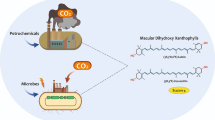Abstract
Xanthophyllomyces dendrorhous (formerly Phaffia rhodozyma) in shake-flask cultures was exposed to 10–20 mmol/L H2O2 at various culture stages, and the astaxanthin production was significantly increased by H2O2 fed at 0 or 24 h (exponential phase), but only slightly at 48 h (near stationary phase). The astaxanthin production was enhanced most significantly with double feeding of 10 mmol/L H2O2 at 0 and 24 h, reaching a cellular content of 1.30 mg/g cell and a volumetric yield of 10.4 mg/L, which were 83 and 65% higher, respectively, than those of the control (0.71 mg/g cell and 6.3 mg/L). The intracellular catalase (CAT) activity was also increased after H2O2 treatment. The increases in CAT and astaxanthin of cells could be detected within 4 h of H2O2 treatment. The increase in the astaxanthin content of cells was concomitant with a notable decrease in the β-carotene content. The older yeast cells at late culture stage (120 h), due perhaps in part to their higher astaxanthin contents, were more tolerant to H2O2 toxicity than the younger cells (24 h). No enhancement of the astaxanthin biosynthesis was attained when H2O2 was added to the yeast culture together with a sufficient amount of exogenous CAT. The results suggest that astaxanthin biosynthesis in X. dendrorhous can be stimulated by H2O2 as an antioxidative response.



Similar content being viewed by others
References
An GH, Schuman DB, Johnson EA (1989) Isolation of Phaffia rhodozyma mutants with increased astaxanthin content. Appl Environ Microbiol 55:116–124
An GH, Chang KW, Johnson EA (1996) Effect of oxygen radicals and aeration on carotenogenesis and growth of Phaffia rhodozyma (Xanthophyllomyces dendrorhous). J Microbiol Biotechnol 6:103–109
Andrewes AG, Phaff HJ, Starr MP (1976) Carotenoids of Phaffia rhodozyma, a red-pigmented fermenting yeast. Phytochemistry 15:1003–1007
Bradford MM (1976) A rapid and sensitive method for the quantification of microgram quantities of protein utilizing the principle-dye binding. Anal Biochem 72:248–254
Ducrey Santopietro LM, Spencer JFT, Spencer DM, Sineriz (1998) Effects of oxidative stress on the production of carotenoid pigments by Phaffia rhodozyma (Xanthophyllomyces dendrorhous). Folia Microbiol 43:173–176
Iigusa H, Yoshida Y, Hasunuma K (2005) Oxygen and hydrogen peroxide light-induced carotenoid synthesis in Neurospora crassa. FEBS Lett 579:4012–4016
Johnson EA, An GH (1991) Astaxanthin from microbial sources. Crit Rev Biotechnol 11:297–326
Johnson EA, Schroeder WA (1995) Microbial carotenoids production. Adv Biochem Eng 53:119–178
Kobayashi M, Kakizono T, Nagai S (1993) Enhanced carotenoid biosynthesis by oxidative stress in acetate-induced cyst cells of a green unicellular alga, Haematococcus pluvialis. Appl Environ Microbiol 59:867–873
Kobayashi M, Kakizono T, Nishio N, Nagai S, Kurimura Y, Tsuji Y (1997) Antioxidant role of astaxanthin in the green algae Haematococcus pluvialis. Appl Microbiol Biotechnol 48:351–356
Liu YS, Wu JY, Ho KP (2006) Characterization of oxygen transfer conditions and their effects on Phaffia rhodozyma growth and carotenoid production in shake-flask cultures. Biochem Eng J 27:331–335
Ma RYN, Chen F (2001) Induction of astaxanthin formation by reactive oxygen species in mixotrophic culture of Chlorococcum sp. Biotechnol Lett 23:519–523
Manjula Rao Y, Sureshkumar GK (2001) Improvement in bioreactor productivities using free radicals: HOCl-induced overproduction of xanthan gum from Xanthomonas campestris and its mechanism. Biotechnol Bioeng 72:62–68
Marova I, Breierova E, Koci R, Friedl Z, Slovak B, Pokorna J (2004) Influence of exogenous stress factors on production of carotenoids by some strains of carotenogenic yeasts. Ann Microbiol 54:73–85
Palozza P, Krinsky NI (1992) Astaxanthin and canthaxanthin are potent antioxidants in a membrane model. Arch Biochem Biophys 297:291–295
Schroeder WA, Johnson EA (1993) Antioxidant role of carotenoids in Phaffia rhodozyma. J Gen Microbiol 139:907–912
Schroeder WA, Johnson EA (1995) Singlet oxygen and peroxyl radicals regulate carotenoid biosynthesis in Phaffia rhodozyma. J Biol Chem 270:18374–18379
Steinbrenner KJ, Linder H (2001) Regulation of two carotenoid biosynthesis genes coding for phytoene synthase and carotenoid hydroxylase during stress-induced astaxanthin formation in the green alga Haematococcus pluvialis. Plant Physiol 125:810–817
Acknowledgements
This work was supported by an internal grant (PE94) and a postgraduate studentship (to Y.-S. Liu) from The Hong Kong Polytechnic University.
Author information
Authors and Affiliations
Corresponding author
Rights and permissions
About this article
Cite this article
Liu, Y.S., Wu, J.Y. Hydrogen peroxide-induced astaxanthin biosynthesis and catalase activity in Xanthophyllomyces dendrorhous . Appl Microbiol Biotechnol 73, 663–668 (2006). https://doi.org/10.1007/s00253-006-0501-8
Received:
Revised:
Accepted:
Published:
Issue Date:
DOI: https://doi.org/10.1007/s00253-006-0501-8




